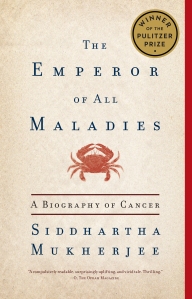 While initially browsing through this Pulitzer Prize winner for General Non-Fiction, I caught a glimpse of the “prevention” chapter which enticed me to read the whole 470 pages of it. It was not just a biography of cancer but also a detailed history of modern medicine. My expectations of learning a thing or two about “prevention” however were never met as that chapter was solely dedicated to the direct link between smoking and lung cancer -nothing new! And that’s where I was hugely disappointed; were there really no other preventative points worthy of mention for a book dedicated to cancer?
While initially browsing through this Pulitzer Prize winner for General Non-Fiction, I caught a glimpse of the “prevention” chapter which enticed me to read the whole 470 pages of it. It was not just a biography of cancer but also a detailed history of modern medicine. My expectations of learning a thing or two about “prevention” however were never met as that chapter was solely dedicated to the direct link between smoking and lung cancer -nothing new! And that’s where I was hugely disappointed; were there really no other preventative points worthy of mention for a book dedicated to cancer?
The author is Dr. Mukharjee, a physician and oncologist. The book is very thorough in its exploration of cancer from the beginning of time to today; from ancient treatments to detailed description of how modern oncology came about -from the British chemical dye manufacturers to WWII weaponry- with the discovery of the chemotherapeutic usage of dyes and mustard gas. There’s also a very detailed description of the peoples and organizations that brought cancer to the forefront of medicine and launched a ‘war on cancer’. He lastly describes the current understanding of cancer and with a thorough investigation of cancer research progress made in the past decades, concludes that although cancer is a part of our genome and there’s no winning this war, there’s been great improvements made in lengthening the cancer patients’ life and increasing the years between relapses.
Below I have chosen some highlights from the book that I found most intriguing describing how we came to be where we are today in terms of cancer treatment and our general medical model.
Although the author does not mention lifestyle factors (other than smoking) that can play a preventative role in cancer, he does have a criticism of the National Cancer Institute’s (NCI) allocation of funds in the 1960’s. He says:
“the cancer virus program [a grand total of one cancer-causing virus leading to the cancer virus theory because viruses were the new rage in all of medicine] siphoned away more than 10% of the NCI contract –nearly 500 million. In contrast, the institute’s cancer nutrition program, meant to evaluate the role of diet in cancer- a question of at least equal import- received one-twentieth of that allocation.” (175-176).
What I found unusual and refreshing about this book, was the author’s criticism of the politics of modern medicine and how ego seems to always get in the way of true discovery. For example, the practice of radical mastectomy, a surgical procedure performed needlessly for decades as a “cure” for breast cancer was eventually replaced by more effective and less invasive procedures. About the surgeons and the medical atmosphere of the time he says:
“The hierarchical practice of medicine, its internal culture, its’ rituals of practice, were ideally arranged to resist change and to perpetuate orthodoxy.” And he continues: “’Power’, in the colloquial sense of the word, thus collided with ‘power’ in the statistical sense. The surgeons who had so painstakingly created the world of radical surgery had absolutely no incentive to revolutionize it.” (198).
Unfortunately, history tends to repeat itself. If only more of us in the health care field were aware of the history of medicine so as not to repeat such horrendous practices.
Once a certain practice becomes protocol and maintains its position due to the ego of its practitioners –as described in the above paragraph- it can take decades for the truth to slowly reveal itself. In the case of radical mastectomy, it took eight! One doctor, Dr. Fisher who sought to change this protocol wrote in an article:“The clinician, no matter how venerable, must accept the fact that experience, voluminous as it might be, cannot be employed as a sensitive indicator of scientific validity” (200). In describing the experiences of women undergoing radical mastectomy he writes:“Many chose the procedure, many were forced into it. Many others did not even realize that it was a choice”(201). Medicine has come a long way and informed consent is now common protocol so do practice informed consent and remember, you always have choice!
Unfortunately the chemotherapy doctors weren’t any better than the surgeons. Cancer patients in those days were used as lab rats; studies that would not pass today’s ethical standards were performed as “saving the individual patients [was] not the essential mission….but the basic purpose [was] not to save that patient’s particular life but to find means of saving the lives of others.” (203). Mukherjee writes, “It was trial and error on a giant human scale –with the emphasis, it seemed at times, distinctly on error” (208). It was in the mid 80’s that Rose Kushner (a member of the National Cancer Advisory Board) “warned against the growing disconnect between doctors and their patients. ‘When doctors say that the side effects are tolerable or acceptable, they are talking about life-threatening things.’” (209).
Before I continue any further I’d like to clarify my intentions for writing this book review. It is not my intention to vilify modern medicine –far from it- but to describe the landscape on which modern medicine came about so that you become a better informed consumer of health care.
It was in such conditions in the oncology wards that palliative care emerged in Europe. In cure-obsessed America however there was still much resistance to providing palliative care to patients. A ward nurse recalls, “doctors would not even look us in the eye when we recommended that they stop their efforts to save lives and start saving dignity instead…doctors were allergic to the smell of death. Death meant failure, defeat –their death, the death of medicine, the death of oncology” (226).
After discussing a number of statistical analysis to quantify progress made in cancer treatment, Mukherjee concludes that the only intervention ever known to reduce the aggregate mortality for a disease –any disease- at a population level was prevention. And so again, criticism of the NCI for not allocating more funds for prevention research arises. In 1986 Bailer and Smith in their analysis “Progress against cancer” note that,
“A shift in research emphasis, from research on treatment to research on prevention, seems necessary if substantial progress against cancer is to be forthcoming…Past disappointments must be dealt with in an objective, straightforward and comprehensive manner before we go much further in pursuit of a cure that always seems just out of reach” (234).
It is the sad truth that not much has changed in the past few decades. We are still raising funds to “find a cure”. From breast cancer and the pink ribbon campaign to prostate cancer and Movember, to the Terry Fox Run. And it doesn’t end at cancer. This is an epidemic in all disciplines and specialties of medicine. We are looking for cures. We are at war and we must win. As Mukharjee so eloquently puts it: “The notion of the “cure” as the singular solution to cancer had degenerated into a sclerotic dogma” (234).
The book then goes on to describe the discovery of the link between lung cancer and smoking. But sadly, the prevention chapter ends there. Since this book is a biography of cancer, I’m not surprised that there is no more evidence in the history of cancer for other preventative measures as any such measures are still in their infancy and not yet mainstream.
In describing the physiological mechanisms by which cancer comes about and the most recent understanding of how cancer is eradicated, the author concludes that “we can rid ourselves of cancer, then, only as much as we can rid ourselves of the processes in our physiology that depend on growth –aging, regeneration, healing and reproduction” (462). Although this is true that “cancer is a flaw in our growth” this ‘flaw’ does not mean that every cancerous cell produced by our body needs to become a malignant tumour or to metastasize. As much as cancer is in our genome, so is the intelligent removal of cancer cells inherent in our physiology.
Mukharjee describes successes in the treatment of leukemias and a number of other uncommon cancers for which chemo and radiation therapy combinations are very effective. But for many other cancers such as colon, liver, breast, and prostate, just to name a few, the contributing preventative factors rooted in our lifestyles are now well understood and play a great role much like the link between smoking and lung cancer. Let’s hope that in the next few decades, the ‘prevention’ chapter comprises much more of such a book as we as a society practice preventative medicine on a larger and larger scale; then perhaps we can also cause statistically significant strides in the eradication of this disease –unlike the current state of cancer treatment progress where the best we can measure is number of survival years post-treatment where quality of life doesn’t even factor in on such measurements.
Unfortunately however, the nutrition and cancer link is currently in a state where although the knowledge is there, but just like the tobacco industry who ran their advertisements in medical journals and “at the annual conferences of the American Medical Association in the early 1950’s, cigarettes were distributed free of charge to doctors”, our food industry also needs to undergo a complete overhaul to remove the toxic substances evidently known to cause cancer (251). It took two decades from the first signs of an association between lung cancer and smoking to the final report confirming the causal relationship that laid decades of doubt and debate to rest. Since then, much has improved in terms of cigarette regulations and with increased awareness, less and less individuals choose to pick up this deadly habit. The sad truth however is that with tighter regulations here in North America, tobacco industries have been targeting the developing world. In a recent editorial in the British Medical Journal, Stanton Glantz (epidemiologist) describes, “Multinational cigarette companies act as a vector that spreads disease and death throughout the world” (274).
Overall, I found this book to be a great description of the reality of modern medicine’s approach to cancer. Sadly though, there isn’t a happy ending to this book as the author concludes that there isn’t much to be done with cancer as it’s written in our genome. But he does make a good point that if we are to wage a war on cancer, we are better off focusing our resources and energy on its prevention! I must say, as a naturopath, I’m in full agreement.




You deliberately and thoughtfully brought to light Dr. Mukherjee’s research in this excellent review. I am gratified that your endeavours in your own practice continue to focus on resources and placing your energies on prevention, not only for cancer for for all conditions. Continue your good work!
Thank you for your kind review. As you mention, prevention is the key to not just cancer but most diseases and conditions plaguing society today.
Great posts Negin!